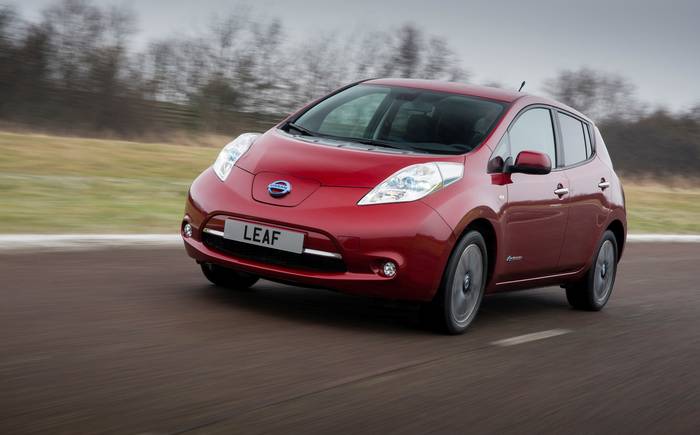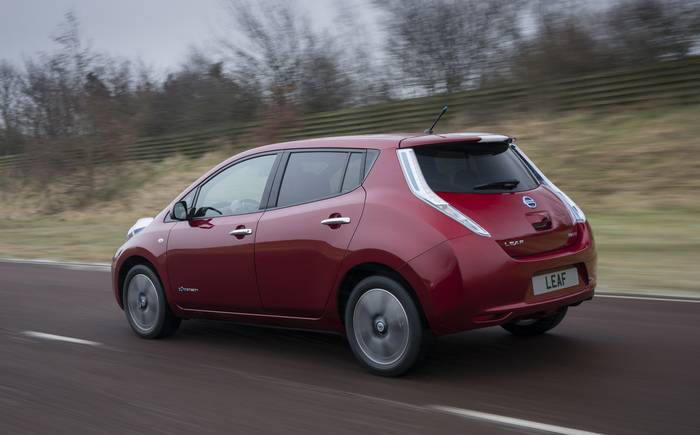Nissan Leaf review (2011-on)
For the driver with a green conscience but modest touring ambitions

What is the Nissan Leaf?
The Nissan Leaf is now the electric car with a touch of “wae’aye man”, as production was moved from Japan to the company’s Sunderland plant in 2013.
In addition to its Tyneside heritage, the Leaf was updated at the time, with an enhanced range (a claimed 124 miles compared with the 2011 original’s 109 miles), a fast 6.6kW optional charger and a larger boot.
Priced from £20,990 (after the £5,000 plug-in grant) it competes with pure-electric cars including the prettier, cheaper but much smaller Renault Zoe (from £13,995 after plug-in grant deduction) and the BMW i3 (from £25,680 after grant).
Meanwhile, though not a pure electric car, the similarly-sized Vauxhall Ampera (starting at £28,750 after grant deduction), which features a small, range-extending, 1.4-litre petrol-driven generator to provide additional electricity, is nevertheless a viable alternative. And in the hybrid petrol/electric corner is the Toyota Prius, starting at £21,845.
Search for and buy used Nissan Leaf on driving.co.uk
The car was launch in a single high specification but since 2013 there are three trim levels to choose from: Visia, Acenta and Tekna. The Visia’s steel wheels and dial-type, auto air-conditioning say much about the model’s entry-level aspirations. For an extra £2,500, Acenta brings welcome extras including Nissan’s useful CarWings telematics and sat nav systems. In addition, it has digital air conditioning, a rapid-charge port and alloy wheels. The Tekna’s £2,000 premium adds a BOSE sound system, and heated leather seats and steering wheel.
You can buy a Leaf outright with its battery or lease both items separately from £119 per month for the car and £70pm for the battery, both over three years, driving 7,500 miles per year. There’s a £4,083 deposit to pay. What you won’t have to pay, however, is car tax, the London congestion charge, parking at most public charging points and, if you’re a company driver, benefit-in-kind tax.
The drive

An electric motor produces its maximum torque from the start. You can feel it in the way the pressure you apply to the Leaf’s accelerator pedal produces a perfectly matched response from the motor. There’s no hesitancy and no lag. Underway, the Leaf pulls strongly enough but select “B” via the transmission knob and considerably more power is made available for acceleration. In normal running, regenerative braking, when you lift off the accelerator, is strong, capturing energy and feeding it back to the battery but in B mode, this effect is reduced for a smoother ride.
The Leaf’s brakes are a little soft initially but they build pressure strongly. The suspension soaks up most urban dents and with assistance from the car’s hefty 1,567kg kerb weight does a fine job of flattening out A-road undulations and dips. Fast cornering shows up the car’s slightly woolly steering but it’s still entertaining. In fact, for a car with such a limited range, the Leaf is frustratingly good to drive.
The Leaf offers many ways to monitor how efficiently you’re driving while, on the main screen, is an energy consumption display (for example, switch the heating off and you can see the range counter gain miles). As the range counter is calculated on very recent driving conditions, it’s a little difficult to predict actual range on a longer run.
For example, one tester who embarked on his 43-mile drive from work to home with 80 miles range displayed, arrived at his destination with 27 miles remaining. He recharged the car overnight on the mains (at a cost in electricity of around £2.50) and with the range restored to 80 miles retraced his steps. This time he arrived at work with 40 miles range left. What’s more, he had driven a little less tentatively than the night before, turned up the heating and switched on the heated seats, just to see how fast they’d drain the system. With experience, though, such idiosyncracies needn’t be a serious problem and at least the three-pin charging solution means the car can be easily topped up, though you should expect to see only a few additional miles of range for a half hour charge on a standard domestic socket. A full charge takes roughly 10 hours, meaning the car should have a full battery after being plugged in overnight.
The interior
Just like its exterior, the Leaf’s interior shouts, “I’m different”. A large black control unit, looking much like a computer tablet, dominates an otherwise hard, plasticky fascia. It features ventilation controls and a soft-touch display incorporating sat nav, Nissan CarWings (which permits remote control of, among other things, the Leaf’s charging, and heating and ventilation systems via a phone or computer) and energy consumption data.
The dashboard is modular in layout with related functions all neatly grouped, but it all looks a bit Buck Rogers. In addition to the central control unit, there’s a split-level display ahead of the driver; the top portion above the steering wheel giving essential information such as speed and driving efficiency, the lower, larger portion visible through the steering wheel providing further energy data including real-time power consumption and remaining range. For energy obsessives, the Leaf must be heaven, but for the driver who simply wants to go from A to B, all these ways of accessing the same, detailed information can be a tad distracting, and unnerving.
The needlessly small transmission knob is another example of the Leaf’s self-conscious styling. It’s quite fiddly at first, requiring only small movements to engage the various modes. A ham-fisted driver could easily mis-select. It took one tester some time to realise that to select neutral, you push the knob to the right as indicated but, crucially, hold it there.
Otherwise, the cabin is competent and practical ‒ plenty of headroom and legroom in the rear, and comfortable seats. The boot is a little narrow but split fold seats ensure it is at least flexible.
What to look for when buying a used Nissan Leaf
Electric vehicles are inherently simple devices with a motor, a battery pack, no gearbox and many fewer moving mechanical parts than their internal-combustion counterparts, so there’s less to go wrong. The major concern is battery life, and one British fleet of electric cars has already reported a deterioration in battery capacity, although most problems have so far been recorded only in very high-temperature environments, such as in the American state of Arizona.
Ask questions about how the car has been looked after, and be wary if it has sat idle for a long time without being charged – it’s better for the lithium ion battery to be plugged in and topped up with an automatically-managed trickle charge. Be especially wary if the car has been left for extended periods with an empty battery – this could leave it less able to hold charge in the future. We advise taking it for a test drive from full charge and keeping an eye on the battery level gauge.
Offering peace of mind, Nissan now provides an additional five-year/60,000-mile warranty from new for all electric-vehicle-specific components – including the batteries – in addition to the existing standard three-year cover. It expects batteries to maintain 80% of their original capacity after five years and still to have 70% at 10 years, providing they are used and charged “normally”.
Watch out for glitches older Leafs’ air-conditioning units, control software and Carwings sat nav/telematics system, as well as some minor initial defects in build quality – by no means unusual for a newly launched car.
You are best off buying from a Nissan franchise to be sure you’re getting the best possible warranty cover and service back-up.
The one to buy
2013 Nissan Leaf Acenta
Specifications
Price: £23,490 – after plug-in car grant (Correct at time of publication)
Motor: 80kW AC
Power: 107bhp @ 2730rpm
Torque: 206 lb ft @ 0-1750rpm
Transmission: Automatic
Acceleration: 0-62mph in 11.9sec
Top speed: 90mph
Range: 124-miles (official figure)
CO2: 0g/km at tailpipe
Road tax band: 100% discount
Dimensions: L 4445mm, W 1770mm, H 1550mm
Nissan Leaf rivals
- Vauxhall Ampera (Check used Vauxhall Ampera prices on driving.co.uk)
- VW Golf (Check used VW Golf prices on driving.co.uk)
- Toyota Prius (Check used Toyota Prius prices on driving.co.uk)




